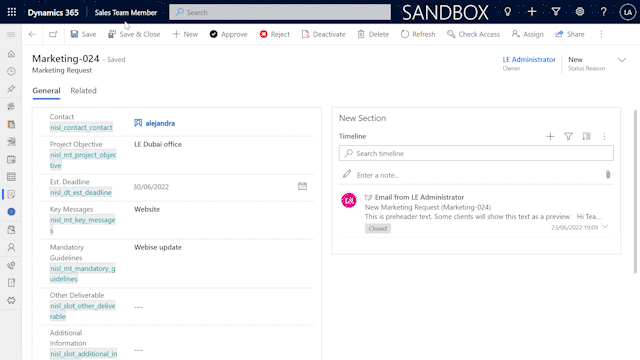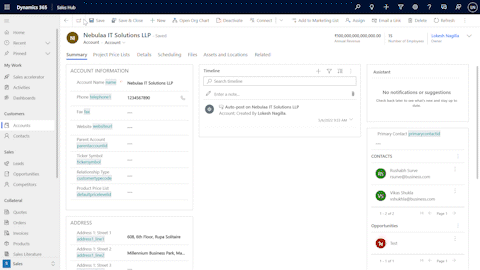When a form displays a business process flow control in the header, additional controls gets added for each attribute that is been displayed in that BPF.
These controls hold unique names like: header_process_<attribute name>.
When a form displays a business process flow control in the header, additional controls gets added for each attribute that is been displayed in that BPF.
These controls hold unique names like: header_process_<attribute name>.
V 4.2.2
--- BEGIN LICENSE KEY ---
H1bJTd2SauPv5Garuaq0Ig43uqq5NJOEw94wxdZTpU-pFB9GmyPk677gJ
vC1Ro6sbAvKR4pVwtxdCfuoZDb6hJ5bVQKqlfihJfSYZt-xVrVU27+0Ja
hFbqTmYskatMTgPyjvv99CF2Te8ec+Ys2SPxyZAF0YwOCNOWmsyqN5y9t
q2Kw2pjoiDs5gIH-uw5U49JzOB6otS7kThBJE-H9A76u4uUvR8DKb+VcB
rWu5qSJGEnbsXNfJdq5L2D8QgRdV-sXHp2A-7j1X2n4WIISvU1V9koIyS
NisHFBTcWJS0sC5BTFwrtfLEE9lEwz2bxHQpWJiu12ZeKpi+7oUSqebX+
--- END LICENSE KEY -----
The above license key only applies to version 4.2.2.
How to filter Option Set Field options based on form
In some scenarios, we may need to filter the option set types of fields' options based on some conditions.
Sometimes we may need to capture user's signature in Dynamics 365.
How to exceed 50 characters maximum label length limitation to set a long label for the Dynamics 365 CE fields.
As we know there is a 50 characters maximum length limitation for the fields(columns) labels of entities(tables) in Dynamics 365 CE.
Sometimes, we may need a longer label than 50 characters. How to do that?
https://nebulaaitsolutions.com/newly-introduced-client-script-methods-for-d365-ce/
This blog will talk about the new client script methods that can enhance UI/UX experience.
This method adds an option to your choice/choices control.
formContext.getControl(arg).addOption(option, index);
Removes an option from a choice/choices control.
formContext.getControl(arg).removeOption(value);
Clears all options from a choice/choices control.
formContext.getControl(arg).clearOptions();
Sets the focus on the control.
formContext.getControl(arg).setFocus();

Sets the label of the control.
formContext.getControl(arg).setLabel(label);
Adds an event handler to the OnLookupTagClick event.
OnLookupTagClick:- This event occurs when the user clicks the tag in a lookup control.
formContext.getControl(arg).addOnLookupTagClick(myFunction);Provides all the information to create side panes.
Xrm.App.sidePanes.createPane(paneOptions);Click here to learn more about paneOptions

https://www.c-sharpcorner.com/article/creating-html-web-resource-to-show-image-attached-in-notes-using-web-api/
Some time back, I wrote a post for retrieving an image attached to notes using OData, as now for Dynamics 365 CE, we use Web API. So, I am going to share how we can do it using Web API.
Microsoft Dynamics CRM stores all the notes and attachments in annotation entities. Most out of the box entities used to have a relationship with this entity, but while creating our custom entity we can specifically select if we want to associate our custom entity with notes or not use the following option under Communication & Collaboration. Keep in mind once you enable this option, there is no way to disable this option, but if you are not sure, if you need notes or not at the time of your entity creation it's better to leave this option un-selected, so that you can select this option after sometime if required.
Note
The default size for notes attachment is 5 MB but if required, you can increase this limit to up to 32 MB.
Get entity image from notes
Similar to earlier versions we can upload the image to notes in Dynamics 365 CE.
Once image is attached to notes, we can retrieve it using Web API retrievemultiple request where we can query notes based on ObjectId field, we need to pass entity id field for objectid field in notes. We can using following code, in our html webresource,
Create and deploy html web resource
Now, we need to create an HTML web resource and use the above code under Text Editor.

After that, we can put this web resource to our required Entity Form and we should be able to see the first attached image in web resource after refreshing the page.
Next we will explain how to create a HTML web resource and use our JavaScript method to get and display the image. We need to implement the following two steps:
· Create HTML page
· Deploy HTML page and SDK.REST.js using web resource
Create HTML page
Create a HTML page using a HTML editor. Use the following code for the HTML page:
Deploy HTML page and SDK.REST library using web resource
Use following procedure to deploy a HTML page and SDK.REST library in Microsoft CRM.


Note: Please refer to my previous article for the SDK.REST.js location.
Now we can place our HTML web resource in the account entity form by navigating to Insert -> Web Resource options. Save your changes and then publish the account entity form.
